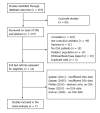Safety of gastrointestinal endoscopy with conscious sedation in obstructive sleep apnea
- PMID: 29184611
- PMCID: PMC5696607
- DOI: 10.4253/wjge.v9.i11.552
Safety of gastrointestinal endoscopy with conscious sedation in obstructive sleep apnea
Abstract
Aim: To perform a systematic review and meta-analysis to assess the safety of conscious sedation in patients with obstructive sleep apnea (OSA).
Methods: A comprehensive electronic search of MEDLINE and EMBASE was performed from inception until March 1, 2015. In an effort to include unpublished data, abstracts from prior gastroenterological society meetings as well as other reference sources were interrogated. After study selection, two authors utilizing a standardized data extraction form collected the data independently. Any disagreements between authors were resolved by consensus among four authors. The methodological quality was assessed using the Newcastle Ottawa tool for observational studies. The primary variables of interest included incidence of hypoxia, hypotension, tachycardia, and bradycardia. Continuous data were summarized as odds ratio (OR) and 95%CI and pooled using generic inverse variance under the random-effects model. Heterogeneity between pooled studies was assessed using the I2 statistic.
Results: Initial search of MEDLINE and EMBASE identified 357 citations. A search of meeting abstracts did not yield any relevant citations. After systematic review and exclusion consensus meetings, seven studies met the a priori determined inclusion criteria. The overall methodological quality of included studies ranged from moderate to low. No significant differences between OSA patients and controls were identified among any of the study variables: Incidence of hypoxia (7 studies, 3005 patients; OR = 1.11; 95%CI: 0.73-1.11; P = 0.47; I2 = 0%), incidence of hypotension (4 studies, 2125 patients; OR = 1.10; 95%CI: 0.75-1.60; P = 0.63; I2 = 0%), incidence of tachycardia (3 studies, 2030 patients; OR = 0.94; 95%CI: 0.53-1.65; P = 0.28; I2 = 21%), and incidence of bradycardia (3 studies, 2030 patients; OR = 0.88; 95%CI: 0.63-1.22; P = 0.59; I2 = 0%).
Conclusion: OSA is not a significant risk factor for cardiopulmonary complications in patients undergoing endoscopic procedures with conscious sedation.
Keywords: Complications; Conscious sedation; Endoscopy; Meta-analysis; Obstructive sleep apnea; Safety.
Conflict of interest statement
Conflict-of-interest statement: The authors deny any conflict of interest. This manuscript is not under consideration elsewhere.
Figures
Similar articles
-
Safety of Gastrointestinal Endoscopy With Conscious Sedation in Patients With and Without Obstructive Sleep Apnea.J Clin Gastroenterol. 2016 Mar;50(3):198-201. doi: 10.1097/MCG.0000000000000305. J Clin Gastroenterol. 2016. PMID: 25768974
-
Diagnostic techniques and surgical outcomes for persistent pediatric obstructive sleep apnea after adenotonsillectomy: A systematic review and meta-analysis.Int J Pediatr Otorhinolaryngol. 2019 Jun;121:179-187. doi: 10.1016/j.ijporl.2019.02.030. Epub 2019 Mar 3. Int J Pediatr Otorhinolaryngol. 2019. PMID: 30925395
-
Do patients at risk of sleep apnea have an increased risk of cardio-respiratory complications during endoscopy procedures?Sleep Breath. 2012 Sep;16(3):609-15. doi: 10.1007/s11325-011-0546-5. Epub 2011 Jun 27. Sleep Breath. 2012. PMID: 21706289
-
Safety of conscious sedation in patients with sleep apnea in a veteran population.South Med J. 2011 Mar;104(3):185-8. doi: 10.1097/SMJ.0b013e318205e55e. South Med J. 2011. PMID: 21297544
-
Association Between Obstructive Sleep Apnea and Osteoporosis: A Systematic Review and Meta-Analysis.Int J Endocrinol Metab. 2016 Jul 2;14(3):e36317. doi: 10.5812/ijem.36317. eCollection 2016 Jul. Int J Endocrinol Metab. 2016. PMID: 27942262 Free PMC article. Review.
Cited by
-
Severity of obstructive sleep apnea diagnosed incidentally during gastrointestinal endoscopy under conscious sedation.Sleep Breath. 2025 Mar 26;29(2):139. doi: 10.1007/s11325-025-03289-0. Sleep Breath. 2025. PMID: 40140140
-
Predictor of respiratory disturbances during gastric endoscopic submucosal dissection under deep sedation.World J Gastrointest Endosc. 2020 Oct 16;12(10):378-387. doi: 10.4253/wjge.v12.i10.378. World J Gastrointest Endosc. 2020. PMID: 33133374 Free PMC article.
-
British Society of Gastroenterology guidelines on sedation in gastrointestinal endoscopy.Gut. 2024 Jan 5;73(2):219-245. doi: 10.1136/gutjnl-2023-330396. Gut. 2024. PMID: 37816587 Free PMC article.
-
Korean clinical practice guidelines for diagnostic and procedural sedation.Korean J Anesthesiol. 2024 Feb;77(1):5-30. doi: 10.4097/kja.23745. Epub 2023 Nov 16. Korean J Anesthesiol. 2024. PMID: 37972588 Free PMC article.
References
-
- Faigel DO, Baron TH, Goldstein JL, Hirota WK, Jacobson BC, Johanson JF, Leighton JA, Mallery JS, Peterson KA, Waring JP, et al. Guidelines for the use of deep sedation and anesthesia for GI endoscopy. Gastrointest Endosc. 2002;56:613–617. - PubMed
-
- Rabeneck L, Paszat LF, Hilsden RJ, Saskin R, Leddin D, Grunfeld E, Wai E, Goldwasser M, Sutradhar R, Stukel TA. Bleeding and perforation after outpatient colonoscopy and their risk factors in usual clinical practice. Gastroenterology. 2008;135:1899–1906, 1906.e1. - PubMed
-
- Anderson ML, Pasha TM, Leighton JA. Endoscopic perforation of the colon: lessons from a 10-year study. Am J Gastroenterol. 2000;95:3418–3422. - PubMed
-
- Levin TR, Zhao W, Conell C, Seeff LC, Manninen DL, Shapiro JA, Schulman J. Complications of colonoscopy in an integrated health care delivery system. Ann Intern Med. 2006;145:880–886. - PubMed
LinkOut - more resources
Full Text Sources
Other Literature Sources
Miscellaneous






